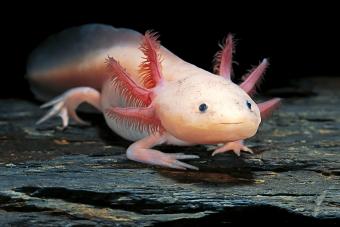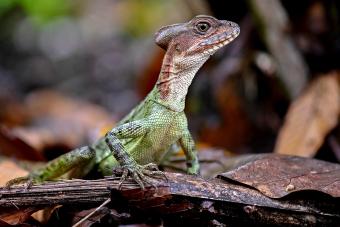
If you're looking for a pet axolotl of your own, you might be overwhelmed by the vast varieties of shades they come in. There are currently 15 axolotl color variations and morphs. Five of these are widely available, while many of the others are very rare or even illegal to purchase or trade in. Discover which you find the most attractive and which colors you may not want to consider.
1. Leucistic

Leucistic, also referred to as "pink," is one of the most common color variations found in captive pet axolotls. In the wild, these axolotls are very rare, as they cannot camouflage well. Leucistics are a translucent shade that almost resembles a pale pink. Their gills are a dark pink color, and they have dark eyes. This morph is caused by a genetic mutation that interferes with pigment cells.
2. White Albino

White albino axolotls look similar to the leucistic varieties. However, these pets have absolutely no pigment. Because of this, their eyes appear pink or red rather than black like leucistics. White albino axolotls are incredibly sensitive to light and should have ample hiding areas to protect their skin and eyes.
3. Golden Albino

The golden albino morph variation is another common axolotl color. These amphibians look identical to white albinos as juveniles but develop their color when they mature. They appear a golden yellow shade with pink gills and pink or red eyes.
4. Wild

As the name implies, this color variation is the one most commonly found in the wild. It's also frequently seen in captive axolotls. Wild morphs are dark in color, but can vary from gray to dark green to brown. These axolotls are typically darker as juveniles, then their color becomes lighter as they mature. Individuals of this color still need dim light, but may be less sensitive than albino or leucistic axolotls due to their pigment.
5. Melanoid

Known as black melanoid, this axolotl color is darker than the wild. Melanoids range from dark grey to black. They lack iridophores, which are the cells that make many other axolotl morphs shiny in appearance. This color variety can change their shade based on the substrate in their enclosure. Therefore, a darker substrate will cause your axolotl to appear a darker tone, while a lighter material will make them look lighter.
6. Speckled Leucistic

Speckled leucistic axololts, also referred to as harlequin or "dirty Lucy" axolotls, are identical to leucistic axolotls, aside from dark speckles on their body. These freckles can appear on the tail, head, or body. They develop as the pet matures.
7. High Iridophore Golden Albino

A mutation of the golden albino axolotl, the high iridophore golden albino appears as a shiny, reflective golden color. They possess a high number of iridophores, which are pigment cells that reflect light, which gives them that incredible shine.
8. Copper

Copper axolotls are considered albino, but possess more pigment than the white and golden albino morphs. For this reason, they have red eyes, though their bodies appear a shimmery copper color. They can range in tone from greyish to rich caramel. Copper axolotls are uncommon and are sometimes bred with other varieties to create unique morphs.
9. Axanthic

Axanthic axolotls can be challenging to identify because they resemble some other morphs. These axolotls are unique in that they lack yellow or red pigment cells. As a result, axanthics look similar to melanoids.
10. Green Fluorescent Protein (GFP)

Under natural light, the green fluorescent protein axolotls could be mistaken for another morph. But under ultraviolet (UV) light, they look almost supernatural, as their entire body glows a vibrant green color. This axolotl variation was genetically engineered in 2005 by scientists at the Max Planck Institute to help track tissue regeneration (a unique trait of the axolotl species). These GFP axolotls are uncommon but can be found through some private breeders. Just note that they are illegal to own in many countries and certain states in the U.S.
11. Silver Dalmatian

Also referred to as a lavender morph, silver dalmatian axolotls are appropriately named for their purple coloring and Dalmatian-like spots. These individuals are hard to come by as this morph is rare, and they are found primarily in the United States.
12. Piebald

Piebald axolotls are leucistic axolotls with dark patchy spots on their head and body. These spots are typically bold and concentrated on the head and dorsal body, though some piebalds can have spots on their sides and legs. They usually have pink, feathery gills. Most piebald breeders are located in New Zealand, so it can be challenging to acquire one.
Sign up for our newsletter featuring all the latest stories and products we love.
13. Firefly

Firefly axolotls are another genetically altered morph achieved through embryonic graphing. These individuals typically have a dark, wild body with an albino tail. They were created by Lloyd Strohl and earned the name "firefly" because their tail portion glows under a UV light.
14. Chimera

The Chimera morph is incredibly rare and equally breathtaking. Chimera axolotls are essentially two morphs, and appear as though someone drew a line down their body, with a white albino appearance on one side and melanoid morph as the other half. These axolotls cannot be bred and are instead a developmental accident.
15. Mosaic

Similar to the chimera morph, mosaics are a rare developmental accident that cannot be bred, so finding one of these as a pet is difficult. These axolotls are a combo of leucistic and wild varieties and feature a beautiful dappled pattern with dark and translucent patches.
Choosing the Perfect Axolotl

Once you know what color appeals to you most, use these tips to ensure you get a healthy new pet:
- Only use a reputable breeder
- Look for an axolotl that doesn't have blemishes, wounds, or other signs of injury or infection
- Since these creatures walk on their four legs, ensure that the legs look healthy and the back legs do not appear red (which is a sign of red leg syndrome)
- Opt for an axolotl that is not too thin, but not too fat. It should have a rounded belly, a good muscular structure, and a strong tail.
Learning everything that is involved in axolotl care is essential to making sure your new friend can live its best life.
Different Colors of Axolotls

When deciding which axolotl color you should get, there are a few factors to consider. Think about which you're most drawn to as well as the availability of that specific morph. Some colors are very challenging or even impossible to find. And if a green fluorescent protein axolotl is your goal, make sure they are legal to own in your area of residence. Whichever color of axolotl you get, you've found yourself an adorable and fascinating friend for years to come.







